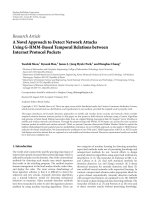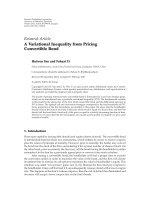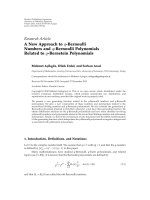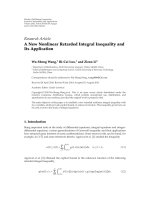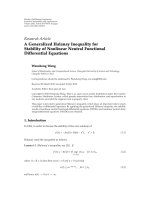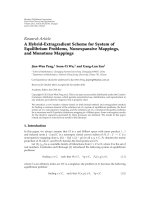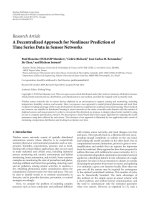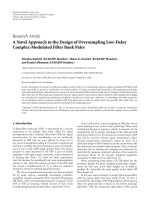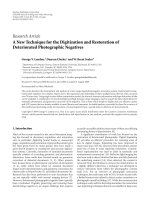Báo cáo hóa học: " Research Article A Variational Approach to the Modeling of MIMO Systems" docx
Bạn đang xem bản rút gọn của tài liệu. Xem và tải ngay bản đầy đủ của tài liệu tại đây (669.62 KB, 10 trang )
Hindawi Publishing Corporation
EURASIP Journal on Wireless Communications and Networking
Volume 2007, Article ID 49350, 10 pages
doi:10.1155/2007/49350
Research Article
A Variational Approach to the Modeling of MIMO Systems
A. Jraifi
1, 2
and E. H. Saidi
1, 2
1
Groupe Canal, Radio & Propagation, Lab/UFR-PHE, Facult
´
e des Sciences, Rabat, Morocco
2
Virtual African Centre for Basic Science and Technology (VACBT), Focal Point Lab/UFR-PHE, Faculty of Sciences, Rabat, Morocco
Received 17 February 2006; Revised 18 June 2006; Accepted 26 March 2007
Recommended by Thushara Abhayapala
Motivated by the study of the optimization of the quality of service for multiple input multiple output (MIMO) systems in 3G
(third generation), we develop a method for modeling MIMO channel H. This method, which uses a statistical approach, is based
on a variational form of the usual channel equation. The proposed equation i s given by δ
2
=δR|H |δE+δR|(δH )|Ewith scalar
variable δ
=δR. Minimum distance δ
min
of received vectors |R is used as the random variable to model MIMO channel. This
variable is of crucial importance for the performance of the transmission system as it captures the degree of interference between
neighbors vectors. Then, we use this approach to compute numerically the total probability of errors with respect to signal-to-noise
ratio (SNR) and then predict t he numbers of antennas. By fixing SNR variable to a specific value, we extract informations on the
optimal numbers of MIMO antennas.
Copyright © 2007 A. Jraifi and E. H. Saidi. This is an open access article distributed under the Creative Commons Attribution
License, which permits unrestricted use, distribution, and reproduction in any medium, provided the original work is properly
cited.
1. INTRODUCTION
Digital communication of the third generation (3G) using
multi-input multi-output (MIMO) is one of the important
techniques used to exploit the spatial diversity in a rich scat-
tering environment [1]. This revival interest in MIMO is pri-
marily dictated by the objective of improving the network’s
quality of service and the op erator’s revenues significantly
[2]. Due to the great spect ral efficiency gain, MIMO systems
have known a great interest nowadays and have been defined
by IEEE 802.16 [3], for fixed broadband wireless access and
3G partnership project (3GPP) for mobile applications. Us-
ing MIMO, it has been shown in [4] that spectral efficiency
can be improved significantly in wireless communications in
fading environment.
Recall that the main objective of the optimization pro-
cess of the MIMO network is to improve the qualit y of ser-
vices for network and to be sure of optimal exploitation of
the resources of network efficiency. For instance, an essential
shutter in MIMO and which will be discussed in this work
is the theoretical determination of the optimal numbers N
T
and N
R
of transmitter and receiver antennas respectively. To
our knowledge, few studies in literature have been devoted
to theoretical approach of MIMO systems. It would be then
interesting to deeper this issue.
To study MIMO system, we will use Rayleigh model as
it is the most widely used method for indoor and urban
channels [5]. When the bandwidth is narrow (flat fading)
[6], our system can be modeled by N
R
∗ N
T
random ma-
trix H .ThereceivedN
R
-vector |R, describing received sig-
nals at reception, is related to the transmitted one
|E as
|R=H |E+|N,where|N is the noise vector with covari-
ance matrix σ
2
I
N
R
with I
N
R
being the N
R
× N
R
unit matrix.
When the bandwidth is large as in WCDMA, OFDM (or-
thogonal frequency division multiplexing) [7]canbeused
to divide the large bandwidth into a narrow ones and for
each subband, the previous model is used. The gains (H
aα
)
(a
= 1, , N
R
, α = 1, , N
T
) of channel matrix are sup-
posed to be independent identically distributed (iid) and are
governed by a circular complex Gaussian random variables
with zero mean and unit variance.
In this work, we use differential analysis and borrow ideas
from quantum scattering theory [8–10]todevelopanewway
to deal with MIMO channel. We first derive a scalar equa-
tion for modeling MIMO channel; then we study the perfor-
mance of MIMO systems for indoor and urban channels by
varying SNR and the antennas numbers N
T
and N
R
. Asso-
ciating the MIMO channel H with the random minimum
distance δ
min
between two generic received vectors |R
a
>
and
|R
b
>, we first study the theoretical expression of total
2 EURASIP Journal on Wireless Communications and Networking
11000101
Coding
Modulation
Mapping
1
.
.
.
N
T
Channel
H
1
.
.
.
N
R
Demapping
Demodulation
Decoding
11000101
Figure 1: Principle of MIMO techniques. Remark that H plays a quite similar role of the quantum scattering theory S-matrix of particle
physics.
probability of errors P
e
= P
e
(N
T
, N
R
, d
0
, σ), where d
0
stands
for the minimal distance between transmitted vectors and
SNR
=−20log
10
(σ). We show in Section 4 that P
e
reads in
generalasfollows:
P
e
=
1
σ
√
π
∞
0
e
−t
2
/4σ
2
1 −
1 − Γ
t
2
/d
2
0
N
R
N
T
dt. (1)
Then we compute numerically P
e
with respect to SNR for
fixed N
T
and d
0
and varying N
R
. By fixing bounds on P
e
for
a given SNR, we study the determination of the theoretical
value of the optimal number of antennas. This theoretical
analysis, which uses a statistical approach, allows to predict
the number of antennas without using long simulations. It
permits as well to optimize the conception of MIMO systems
and the reduction of the cost of its implementation. Notice
by the way that great changes are envisaged to evaluate and
migrate to third genera tion systems (3G). In the fixed net-
work, an evolutionary path is envisaged, whereas in the radio
interface a revolutionary approach is needed to support high
data services [11]. The price to pay for the evolution towards
3G is exorbitant. Research for methods aiming the reduction
of the cost of optimization is then essential.
The presentation of this paper is as follows: in Section 2,
we give preliminaries on MIMO systems and a brief overview
on the third generation (3G) of telecommunications. In
Section 3, we study the performances of MIMO systems deal-
ing with 3G. We first develop the modeling of MIMO channel
by using the random minimum distance variable δ
min
. Then
we compute numerically the probability of errors P
e
in terms
of the signal-to-noise ratio variable (SNR). In Section 4 we
give our conclusion.
2. PRELIMINARIES
We begin by describing briefly the principle of MIMO; then
we give an overview on the 3G mobile systems that support
circuit and packet oriented.
2.1. Principle of MIMO
From a diagram of a MIMO wireless t ransmission system
(see Figure 1), a compressed digital source in the form of a
binary data stream is fedin to a simplified transmitting block
encompassing the functions of error control coding and
mapping to complex modulation symbols (BPSQ, QPSK, M-
QAM, etc.). Each separate symbol stream is mapped onto
one of the multiple N
T
antennas. After filtering and ampli-
fication, the signals are launched into the wireless channel.
At the receiver, the signals are captured by N
R
antennas and
inverse functions are performed to recover the message. For
a SISO (single input single output, N
T
= N
R
= 1) channel,
the capacity C
= C(ρ) reads, in terms of SNR (SNR = ρ), as
C
= log
2
(1 + ρ) bits/sec/Hz [12]. For a SIMO (single input
multiple output, N
T
= 1, N
R
> 1) system, information the-
ory can be used to demonstrate that the capacity is given by
C
N
R
(ρ) = log
2
(1 + ρN
2
R
) bits/sec/Hz [13]. Figure A.1 shows
the variation of capacity in terms of SNR for a SISO and
SIMO systems.
For a MIMO channel, the capacity C of the system is
given by the following general relation [13]:
C
N
T
,N
R
(ρ) = log
2
det
I
N
R
+
ρ
N
T
HH
+
,(2)
where N
T
is the number of transmitters and N
R
the number
of receivers. The variable ρ is the signal-to-noise ratio (SNR),
H is the N
R
∗ N
T
channel matrix with adjoint conjugate
H
+
and the capacity C is expressed with unit bits/sec/Hz.
Note that this equation is based on N
T
equal power uncor-
related sources. Foschini and Gans [4] demonstrated that
capacity C grows linearly in min(N
R
, N
T
). In the particular
case where N
T
and N
R
are large, the average capacity is given
by E(C)
N
R
log
2
(1 + ρ). Figure A.2 shows clearly the im-
provement of the profit in capacity of a system MIMO for
N
T
= 4andN
R
varying in the interval [ 5, 6, , 10]. MIMO
systems advantages are numerous; in particular their ability
to turn multipath propagation, traditionally qualified as a
problem of wireless communications, into a benefit for the
user. MIMO may be also used to increase operator’s rev-
enues. We also recall several techniques, seen as complemen-
tary to MIMO in improving throughput, performance and
spectrum efficiency subject to a growing interest [14], espe-
cially the enhancement of 3G mobile systems; for example,
high speed dig ital packet access (HSDPA). In Table 1,were-
call some simulated MIMO results in 3GPP based on a link
level simulation of a combination of V-Blast and spreading
reuse [4]. The table gives the peak data rates achieved by
the downlink shared channel using MIMO techniques in the
2 GHz bandwith with a 5 MHz carrier spacing under condi-
tions of flat fading.
A. Jraifi and E. H. Saidi 3
Table 1
(N
R
, N
T
) Code rate Modulation Data rate
(1, 1)
3
4
64 QAM 10.8 Mbs
(2, 2)
3
4
64 QAM 14.4 Mbs
(2, 2)
3
4
QPSK 14.4 Mbs
(4, 4)
1
2
8 PSK 21.6 Mbs
Notice moreover that there is a price to pay for improving
quality and revenues since additional antenna increases the
complexity of the system. This is because of the additional
circuits for processing (equalization or interference cance-
lation) needed due to dispersing channel conditions result-
ing from delay spread of the environment surrounding the
MIMO receiver [4].
2.2. Third generation (3G)
Agreatdemandforawiderangeofservices(voice,high
rate data services, mobile multimedia) is expressed by many
users. This leads to a new generation (3G) of mobile sys-
tems, IMT-2000, that support circuit and packet-oriented.
One of the air-interfaces developed within the frame work of
the international Mobile Telecommunications (IMT-2000) is
WCDMA (wide code division multiple access) using a di-
rect spread technolog y that spread encoded user data over
wider bandwidth (5 MHz), a sequence of pseudo-random
units called chips at higher rate (3.84 Mcps) is used.
The basic idea of the 3G system is to integ rate all the net-
works of 2G whole world in only one network and to asso-
ciate it multimedia capacities (high flow for the data). Recall
also that CDMA is a modulation and multiple-access using
a spread spectrum communication which is used in civil-
ian and military communication. It has the ability to combat
multipath interference and increase performance systems.
Within 3G (third generation partnership project) WCDMA
is known as UTRA (universal terrestrial radio access). UTRA
is designed to operate in either TDD mode (Time Divi-
sion Duplex) or FDD mode (frequency division duplex).
The FDD mode uplink (from user equipment (UE) to the
base station (node B)) and downlink transmission (from
node B to UE) deploys separated frequency bands. TDD
is used when uplink and downlink transmissions are per-
formed within the same frequency band in different time
slots. In terms of capacity and receiver complexity, the down-
link is more critical than the uplink.
WCDMA systems suffer from multiple access interfer-
ence (MAI), because the same frequency band is shared by
different users. The desired signal is extracted from its code,
while other signals from system users in the home cell and
other cells covering the service area appear as additive inter-
ference. This received interference is a factor which limits the
radio capacity of the system.
3. PERFORMANCE OF MIMO
One of the basic tasks in dealing with MIMO systems is the
modeling of the channel generally represented by the ran-
dom N
R
∗ N
T
matrix H . Guided by the analysis of [15]and
borrowing ideas from particles scattering theory of quantum
mechanics [8–10], we develop, in the first part of this sec-
tion, a way to approach H using the random variable δ
min
introduced earlier. In the second part, we use the results of
this method to study the performance of MIMO by varying
the N
R
and N
T
numbers and the SNR variable σ. To that pur-
pose, we first consider the simple case N
R
= N
T
= 1, h ≡ H
as a matter to fix the ideas and to make some useful com-
parisons with scattering theory and give our equation to ap-
proach the channel. Then we focus on special aspects of the
channel matrices H with N
R
, N
T
≥ 2. We give, amongst oth-
ers, the general form of the differential scattering equation
for MIMO.
3.1. MIMO channels
We start by illustrating ideas on a simple example. This al-
lows us to show how results on scattering theory of quan-
tum mechanics (QM) can be used to approach MIMO chan-
nels. Thus consider a single-input single-output (SISO) sys-
tem and focus on the channel of the system with matrix h.
Having seen the link between MIMO systems and QM
scattering theory, it is interesting to start by recalling some
useful QM tools. An incoming wave e is generally rep-
resented by a Hilbert space vector denoted as
|e and
called ket. The outcoming vector r, belonging to the dual
Hilbert space H,isrepresentedby
r| and is called bra.
The latter is just the adjoint vector of the ket
|r,(r|=
(|r)
†
). The Hilbert space H is an Euclidean space en-
dowed with the inner product H
× H → C which asso-
ciates to the two vectors f
∈ H
∗
and g ∈ H the scalar
f | g. The ket and bra notations satisfy the usual prop-
erties of the Hilbert space including linearity and normal-
ization; they are very useful in the study of scattering the-
ory and their power comes from the fact that they are
representation independent; one may work either in the
realspaceorintheFourierdualandcanmovefromone
representation together without difficulty; for details see
Appendix A.2.
Using the input vectors
e| and output ones |r, the h
matrix reads in particular as h
=|re|; but in general like
1
h =|r
e|, e | e=1, (3)
where
|r
captures also the noise vector |n which should
be thought as an external source. We suppose that the chan-
nel gains are identical and independently distributed. There-
fore given a transmitted vector
|e, which reads explicitly in
1
The ket and bra notations are conventions borrowed from quantum scat-
tering theory.
4 EURASIP Journal on Wireless Communications and Networking
M-ary modulation (M = 2
n
)as|b
1
, , b
n
where the bit is
taken as b
i
=±1, then the received signal vector |r is,
|r=h|e+ |n. (4)
In the above relations
|r
is equal to |r−|n and like for
|e, the vector |r has the M-ary modulation |j
1
, , j
n
with
j
i
=±1. Before going ahead, note that as far as links with
quantum are concerned, one can make a remarkable corre-
spondence between MIMO channel h and quantum scatter-
ing theory of particles. We have, amongst others, the two fol-
lowing:
(1) Bits
±1 are in one to one with the quantum states
ψ
s,m
of particles of spin s = /2 and spin projection
m
=±/2, where is the Planck constant. This opens
an issue to borrow methods used to describe spin par-
ticles to approach the channel. Note that the state ψ
s,m
is often denoted as |m =±1. This vector may be also
used to describe the bits vector of BPSK modulation.
(2) Equation (3) can be interpreted as just the usual T
if
transition amplitude
T
if
=
r
f
h
e
i
(5)
of quantum scattering theory of spin particles s
= /2
and m
=±/2 moving in some potential. Within this
view one may use QM methods (Green functions) to
compute T
if
to approach SISO channel. We will not
develop this issue here; for a review of the QM meth-
ods; see, for instance, Appendix A.2 and [8–10].
3.1.1. Variational channel equation
Instead of modeling the channel by the typical scattering
equation (4), we propose to rather use the following varia-
tional one,
|δr=h|δe+ δh|e,(6)
where the variation vectors are as
|δv=|v
−|v with |v
standing for |rand |e and where δh describes a fluctuation
of the channel. In the above relation, we have also supposed
a constant static noise (
|δn=0). Moreover, since |δr is an
arbitrary vector, one can put the vector equation (6) into the
following scalar form:
δ
2
=δr|h|δe+ δr|δh|e,(7)
where now δ
=
δr | δr is a random variable that cap-
tures information on the channel and where
δr|=δe|h
+
+
e|(δh
+
)withh
+
being the adjoint conjugate of h.Insteadof
(6), the channel is now modeled by the above scalar relation.
We will turn later on the way this relation can be used in prac-
tice; for the moment let us say few words about the extension
to MIMO.
3.1.2. MIMO case
ThechannelmatrixH of MIMO systems is described by the
following random N
R
∗ N
T
complex matrix w hich reads in
the bra-ket notations as follows:
H
=|R
E|, |R
=|R−|N,(8)
where
|R
may be thought as an N
R
× 1columnvectorand
E| arow1×N
T
one (see (9) below). The matrix H involves
N
T
transmitters, N
R
receivers, and obeys quite similar rela-
tions to SISO; except that in MIMO the previous vectors
|r
and |e get now promoted to larger vectors, namely,
|R=
⎛
⎜
⎜
⎜
⎝
r
1
.
.
.
r
N
R
⎞
⎟
⎟
⎟
⎠
, |E=
⎛
⎜
⎜
⎜
⎝
e
1
.
.
.
e
N
T
⎞
⎟
⎟
⎟
⎠
,
R|=
r
1
, ,
r
N
R
, E|=
e
1
, ,
e
N
T
.
(9)
As such, MIMO channel obeys the following generalized
equation
|R=H |E + |N, forming N
R
equations of type
MISO. The differential version of this equation extending (6)
reads then as follows:
|δR=H |δE+(δH )|E. (10)
By taking the norm, we can bring this relation into various
forms; in particular,
δ
2
=δR|H|δE+ δR|(δH )|E, (11)
where now δ
2
=δR | δR. Using these differential equa-
tions, we will develop, in what follows, the method to model
MIMO channel and its optimization. A closed approach has
been also considered in [15]. The method involves the two
following ingredients: (a) the minimum distance δ
min
be-
tween signal vectors
|R and |R
=|R + |δR at recep-
tion and (b) the optimization of the total probability of er-
rors P
e
= P
e
(σ)topredicttheoptimalnumberofMIMO
antennas.
3.2. Minimum distance as a channel variable
As noted so far, the key point in dealing with MIMO and its
performance is how to model the random channel matrix H .
The latter is in general a non Hermitian rectangular matrix
with the unique data is that it satisfies the scattering equa-
tion H
|E=|R
. This lack of information makes the study
of MIMO and in particular its H matrix not an easy task.
However, there is a clever way to extract information from
this matrix without going into involved mathematical anal-
ysis. The idea is to optimize the above scattering equation
using a variation approach (11) together with special prop-
erties of the space of the complex vectors
|E and |R
.The
idea of the method involves three steps; two of them are sum-
marized just below and the third one will be exposed in next
section 3.3.
(1) First use a variational approach which deals with the
channel not through the usual scattering equation
H
|E=|R
, but rather in terms of its variation as
shown below:
H
|δE=|δR
, (12)
A. Jraifi and E. H. Saidi 5
wherewehavesupposed
H
aα
δH
aα
, a = 1, , N
R
, α = 1, , N
T
. (13)
So the above variational scattering equations reduce to
H
|δE=|δR.
(2) Take the norm of the simplified vector equation (12)
reducing it into a scalar relation
δE|H
†
H |δE=
δR
|δR
where H
†
H is an N
T
∗ N
T
square Hermi-
tian matrix. Then minimize both sides of the resulting
scalar equation leading to the typical relation
δ
min
d
0
h
m
0
| h
m
0
, (14)
for some integer m
0
belonging to the set [1, , N
T
]
and where we have set δ
min
= min(δR
| δR
), d
0
=
δE | δE and |h
m
0
=min(H |δE/d
0
)withh
m
0
|
h
m
0
=|h
m
0
|
2
.
To see how this works in practice, consider two generic vec-
tors
|r
a
and |r
b
and their difference |r
ab
≡|r
a
−|r
b
with
a
= b. To make contact with the variational analysis given
above, this difference can also be read as
|r
ab
=|r
a
+ |δr
a
.
Then compute the minimum of the distance
|r
ab
min
in
terms of the transmitted symbols
|e
ab
and the channel ma-
trix H .Wehave
min
r
ab
min
H
e
ab
, a = b, (15)
where
|e
ab
=|e
a
−|e
b
. Setting δ
min
= min |r
ab
and
d
0
=|e
ab
which is solved as
e
ab
= d
0
e
iθ
m
u
m
,
u
m
n
= δ
n,m
, n, m = 1, , N
T
,
(16)
where
|u
m
= 1 and where the phase e
iθ
m
depends on the
M-ary modulation (θ
m
= 2pπ/M,0≤ p ≤ M − 1). Sub-
stituting this change back into
|r
ab
H |e
ab
gives at
a first stage
|r
ab
d
0
H |u
m
; then using the identity
2
H |u
m
=|R
E|u
m
≡|h
m
,weget|r
ab
d
0
|h
m
.
Therefore, the minimum distance δ
min
equation (15)isgiven
by
δ
min
d
0
min
m=1, ,N
T
h
m
. (17)
Notice that
|h
m
is a vector with components (|h
m
)
a
≡
h
am
, a = 1, , N
R
. Its Hermitian norm vector is h
m
2
=
N
R
a=1
|h
am
|
2
. Notice also that the distribution law for each
channelgainisgivenbyρ
X
a
(x
a
) = 2
√
1/πe
−x
2
a
,withX
a
=
|
h
am
|. Therefore, the probability density of h
m
is given by
a chi-square distribution
ρ
Y
m
(y) =
1
Γ
N
R
y
N
R
−1
e
−y
, Y
m
=
h
m
2
, (18)
2
Notice that {|u
m
} is the canonical vector basis and |h
m
=H |u
m
is
just the mth column of the H matrix.
where Γ(N
R
) = (N
R
− 1)!. Moreover, the cumulative distri-
bution function F
Y
m
(u) (cdf) associated with Y
m
is
F
Y
m
(u) = P
Y
m
<u
=
Γ
u
N
R
, (19)
where Γ
u
(p) is the incomplete gamma function defined
as Γ
u
(p) = (1/Γ(p))
u
0
x
p−1
e
−x
dx. Then the quantity
min
m=1, ,N
T
F
Y
m
(u) = P(min
m=1, ,N
T
Y
m
<u)canbe
also written, using independence property of Y
m
’s, as
(min
m=1, ,N
T
F
Y
m
(u)) = 1 − Π
m=1, ,N
T
P(Y
m
>u), which,
upon using channel gains identity and min
m=1, ,N
T
(Y
m
) =
δ
min
/d
0
, reads as well as 1 − [P([δ
min
/d
0
] >u)]
N
T
.Thus,we
have the result
min
m=1, ,N
T
F
Y
m
=
1 −
1 − P
δ
min
d
0
2
<u
2
N
T
. (20)
By using (19), we finally get
min
m=1, ,N
T
F
Y
m
(u)
=
1 −
1 − Γ
(δ
min
/d
0
)
2
(u)
N
T
, (21)
where Γ
u
(p) stands for the incomplete gamma function de-
fined above. Thus the cdf for a generic δ
min
reads as follows:
F
δ
min
=
1 −
1 − Γ
(δ
min
/d
0
)
2
N
R
N
T
. (22)
Notice that strictly speaking, the cdf is a function depends on
the variables N
T
, N
R
, and the ratio δ
min
/d
0
. But later on we
will fix N
T
and look for the optimal values of N
R
by studying
the variation of the probability of errors P
e
with respect to
SNR.
3.3. Probability of errors for the minimum distance
We begin this section by noting that given a transmitted
vector
|E
i
ofapackageE including the closed neighbors
|E
i
+ δE
i
, one also has the three following vectors at recep-
tion.
(a) The basic received noise free vector
|R
i
=H |E
i
.
(b) Its closed neig hbors; that is, received noise free vectors
|R
i
+ δR
i
=H |E + δE with δH ignored.
(c) The basic received noisy vector
|R
=|R+ |N (23)
with noise vector
|N.
With these received vectors we are in position to complete
the third stage of the three steps mentioned in Section 3.2.
We require the following condition:
N | N less than N − δR | N − δR. (24)
This constraint relation is the condition for disregarding in-
terference between the received noisy vector
|R
and the
received vector
|R + δR associated with the transmitted
|E + δE neighbor to |E. To better see this condition, let us
consider a noise-free received vector
|R
q
and its neighbors
6 EURASIP Journal on Wireless Communications and Networking
|R
p
at δ
min
. Then error appears whenever we have confusion
between two neighbors vectors
R
q
+ |N−
R
p
2
<
R
q
+ |N−
R
q
2
(25)
which leads to the inequality
(|R
q
−|R
p
)
2
< 2ReN |
(R
q
− R
p
). Substituting |R
q
=H |E
q
and |R
p
=H |E
p
and using the identity
E
p
−
E
q
=
d
0
exp
iθ
m
0
u
m
0
(26)
we get the condition
H
|δE
2
< 2d
0
exp
iθ
m
0
Re
N | h
m
0
, (27)
wherewehaveset
|δE=|E
q
−|E
p
. At the minimum dis-
tance δ
min
= d
0
|h
m
0
, the variation of the transmitted vec-
tor
|δE obeys then the following constraint equation:
|δE=d
0
exp
iθ
m
0
u
m
0
. (28)
Usually, the reason of error comes from the similarity be-
tween the received noisy vector H
|E + |N and its near-
est neighbors H
|E + δE. The error appears whenever the
norm of the noisy vector is greater than the distance between
noise received vector and neighbor noise-free received vec-
tors. Thus error occurs when we ha ve
N≥(N − δR),
that is,
N | δR + δR | N
≥δR | δR, (29)
where
V| is the adjoint conjugate of |V and where |δR=
H |δE and δR|=δE|H
†
. Using (16), we have H |δE=
d
0
exp(iθ)H |u
m
0
whichwecanrewriteaswell,byhelpof
(15), as
|δR=(δ
min
/
h
m
0
| h
m
0
)e
iθ
|h
m
0
, where we have
used (17). Putting back into (29), we obtain
1
h
m
0
| h
m
0
Re
e
iθ
N | h
m
0
>
δ
min
2
. (30)
We can rewrite this relation by remembering that the com-
plex random variable υ
=N | h
m
0
/
h
m
0
| h
m
0
is a Gaus-
sian complex circular variable with zero mean and variance
σ
2
. Thus, we have Re(e
iθ
υ) >δ
min
/2, with probability of er-
rors P
e,inf
(Re(e
iθ
υ) >δ
min
/2) =
∞
δ
min
/2
ρ
υ
(x)dx where ρ
υ
(x) =
(1/σ
√
π)exp(−x
2
/σ
2
). Note that for BPSK constellation, θ
takes only one value for a giv en
|E, while for constellation
other than BPSK θ takes more than one value. Using the ex-
pression of ρ
υ
(x), the probability of errors above the lower
bound reads then as follows,
P
e,inf
Re
e
iθ
υ
>
δ
min
2
=
1
2
erf c
δ
min
2σ
. (31)
For the upper bound, we should replace Re(e
iθ
υ) >δ
min
/2
by
|υ| >δ
min
/2. The cdf of |υ|
2
is F
|υ|
2
(u) = P(|υ|
2
<u)or
equivalently as F
|υ|
2
(u) = Γ
u/σ
2
(1) = 1 −exp(−u/σ
2
). For the
upper bound P
e,sup
(δ
min
) = P(|υ|
2
> (δ
min
/2)
2
), the proba-
bility of errors can be put into the form
P
e,sup
δ
min
=
1 − Γ
|υ|
2
δ
min
2
2
=
e
−(δ
min
/2σ)
2
. (32)
Ploting the curves of probability of errors P
e,sup
and P
e,sup
with respect to δ
min
, we see that a good compromise pro-
viding quite good results for usual constellation (other than
BPSK) is given by
P
e
δ
min
=
erf c
δ
min
2σ
=
2
√
π
∞
δ
min
/2σ
exp
−
x
2
dx. (33)
So, the theoretical total probability of errors P
e
can be ex-
pressed as P
e
=
∞
0
[ρ(δ
min
)P
e
(δ
min
)]d(δ
min
), with ρ(x) =
(1/(N
R
− 1)!)x
N
R
−1
exp(−x). By an integr ation by part, we
have
P
e
=−
∞
0
F(t)P
e
(t)dt, t = δ
min
, (34)
where F(δ
min
) is the cumulative distribution function of δ
min
and P
e
(δ
min
) is the derivative of P
e
(δ
min
).
4. THEORETICAL RESULTS
We first describe the method for evaluating P
e
; then we give
our numerical results.
4.1. The method
To compute the total probability of errors in terms of signal-
to-noise ratio (SNR) variable, that is P
e
= P
e
(SNR), we pro-
ceed in steps as follows: first we start from the integral ex-
pression of P
e
(34), then substitute F(δ
min
)asin(22)and
P
e
(δ
min
)by
P
e
δ
min
=
−
1
σ
√
π
exp
−
δ
min
2σ
2
; (35)
we find
P
e
=
1
σ
√
π
∞
0
e
−t
2
/4σ
2
1 −
1 − Γ
t
2
/d
2
0
N
R
N
T
dt. (36)
Up on fixing d
0
for a given constellation, this is a real function
depending on three parameters as shown below:
P
e
= P
e
σ,N
T
, N
R
. (37)
This expression is difficult to compute exactly although it can
be simplified a little bit since a priori the numbers N
T
and
N
R
are two inputs. But here we will deal with them as mod-
uli fixed by physical considerations, statistics and desired ser-
vices. Next, we adopt a numerical approach to evaluate this
quantity. In our computation, we use the following method.
(1) We fix once for all the numbers of transmitter an-
tennas as N
T
= 2 reducing the previous P
e
moduli depen-
dence to P
e
(σ,N
R
). This is because of electromagnetic in-
teraction of antenna elements on small platform and the ex-
pense of multiple down-conversion RF paths [16], the im-
plementation of diversity at user mobile in 3G which cannot
supportmorethantwoantennasisdifficult. Note that N
R
must be greater than N
T
, otherwise some power is wasted.
For instance, in case where the power is allocated uniformly
over the t ransmitter, there will be an average power loss of
10 log
10
(N
T
/N
R
).
A. Jraifi and E. H. Saidi 7
(2) To deal with the two remaining moduli N
R
and σ,we
proceed as follows.
(a) We choose the number of receiver antennas N
R
into
an interval lying from 3 to 9 (3
≤ N
R
≤ 9). For
each choice of N
R
, P
e
(σ,N
R
)becomesaoneparameter
function which we denote as P
e,N
R
(σ).
(b) Comparing the values of P
e,N
R
(σ) for each choice of
N
R
, one gets information on the optimal value of N
R
for a given value of σ.
(3) To extract information on the optimal value of N
R
,
we draw the par ametric curves P
e,N
R
= P
e,N
R
(SNR) with
SNR(db) which is equal to
−20 log
10
σ. Recall by the way that
SNR(db)
= 10 log
10
(P
T
/P
N
)withP
T
and P
N
defining, re-
spectively, the transmitted power and the power associated
with noise at reception. By implementing the expression of
the noise covariance matrix, namely σ
2
I
N
R
, and normalizing
the total transmitted power to 1, one gets the above relation
between SNR and variance σ
2
.
4.2. Numerical results
Below we give our numerical results. These are grouped in
the form of figures illustrating the variation of the total prob-
ability of errors with respect to SNR.
Notice that as we are interested in 3G, we have adopted
the structure of WCDMA physical layer that assumes QPSK
modulated data streams assembled into 10 millisecond
frames. We recall also that the minimum distance d
0
between
the transmitted symbols in a QPSK modulation is
√
2.
From Figure 3, we learn the three following:
(i) For a given SNR and for a desired value of probability
of errors, we can determine the number of antennas to in-
stall. Choosing a MIMO performance with total probability
of errors as
P
e,N
R
(SNR) < 10
−6
(38)
at SNR
= 6 dB, we find that the required number of received
antennasisatleastN
R
= 9. As we can see, this number is too
high because of the required high performance. Relaxing this
requirement by choosing for instance P
e,N
R
(SNR) < 10
−3
we
get N
R
= 4. The number of antennas at reception strongly
depends then on the precision of P
e,N
R
(SNR).
(ii) Knowing that the choice of the probability of errors
depends on the type of service we want to send on the chan-
nel (voice, data, image), we can, by help of Figure 2,deter-
mine the optimal value of the received antennas as shown on
Table 2.
(iii) The same approach may also be used for other tech-
niques such as EDGE, HSDPA, and WIMAX using, respec-
tively, the modulations 8-PSK, QAM, and QPSK. In these
techniques, the same relation for the probability of errors
(36) is valid except that now we have to vary the mini-
mum inter-distance d
0
between transmitter signal vectors.
For instance, for QPSK, d
0
=
√
2, and for 8-PSK we have
d
0
=
2 −
√
2.
10987654321
SNR (db)
10
−11
10
−10
10
−9
10
−8
10
−7
10
−6
10
−5
10
−4
10
−3
10
−2
10
−1
Probability of error
N
R
= 3
N
R
= 4
N
R
= 5
N
R
= 6
N
R
= 7
N
R
= 8
N
R
= 9
Figure 2: Theoretical probability of errors.
10987654321
SNR (db)
1
1.5
2
2.5
3
3.5
4
4.5
5
5.5
Capacity (b/s/Hz)
SIMO
SISO
Figure 3: Variation of capacity C with respect to SNR. Upper curve
describes SIMO and lower one is for SISO.
Table 2
SNR 55
P
e,N
R
(SNR) 10
−2
10
−6
Service Voice Multimedia
Required N
R
38
5. CONCLUSION
In this paper, we have developed a model proposal for
studying MIMO channel and its per formances. Instead of
8 EURASIP Journal on Wireless Communications and Networking
the usual channel vector equation |R=H |E+|N,we
have proposed a variational relation for approaching MIMO
channel; see (7)–(11). This is a scalar equation involving the
minimum distance δ
min
as a random variable. Restricting
our analysis to the case δH
0, we have shown that much
on the MIMO channel is encoded in the minimum distance
δ
min
= min(
δR | δR)betweenreceivedvectors|R and
|R+δR.
Moreover, we have considered the theoretical determina-
tion of the number of antennas in MIMO systems combined
to the third generation. This approach, which agrees with the
study of [15], is important because it is easy to implement for
predicting the theoretical optimal number of antennas.
Furthermore, if one succeeds to integrate some system
parameters into the above theoretical result, this approach
could also be used for other applications. Digital modula-
tion such as QPSK (quadrature phase shift keying) and QAM
(quadrature amplitude modulation) are used for many com-
munication systems 3G, WIFI, HSDPA, and WIMAX. The
probability of errors for constellations using HSDPA and
WIMAX (QAM, QPSK) is given by the same equation (36).
This means that the same analysis and quite similar results
can be applied for other new technologies such as HSDPA
and WIMAX technologies.
APPENDIX
We give two Appendices A.1 and A.2:inAppendix A.1 we
give figures describing the variation of capacity C w ith re-
spect to signal-to-noise ration (SNR). In Appendix A.2,we
describe briefly the link between MIMO channel and wave
scattering theory of quantum mechanics.
A.1. MIMO capacity
We g ive two figures; Figure A.1 illustrates the variation of
MIMO (SISO and SIMO) capacity C with respect to SNR
and Figure A.2 illustrates its average for various numbers N
R
of received antennas.
A.2. General wave scattering theory
In this appendix Section, we show briefly how standard
methods of scattering theory can be used to study MIMO
channel. Here we exhibit rapidly the par allel between the
channel equation of radio propagation and the so-called
Born series of scattering theory of quantum physics; for refer-
ences on applications of methods of scattering theory see for
instance [17–19]. For other applications of methods of math-
ematical physics, such as large random matrices and maxi-
mum entropy principle, see Wigner proposal [20, 21]. Notice
that as the subject of scattering theory is very huge, we will
content ourselves here to expose the basic idea by giving the
main lines of this correspondence. We hope to come back in
a future occasion to give more details on how methods and
results of scattering theory could be used in MIMO engineer-
ing.
10987654321
SNR (db)
5
10
15
20
25
30
35
Capacity (b/s/Hz)
MIMO channel
N
R
= 10
N
R
= 9
N
R
= 8
N
R
= 7
N
R
= 6
N
R
= 5
Figure A.1: Average capacity for MIMO systems. Curve in bottom
is for N
R
= 5 and top one for N
R
= 10.
Incidental waves
Scattered wave
Obstacles
Scattered waves
Figure A.2: Illustration of scattered phenomenon.
Link between channel equation and Born series
For readers who are not familiar with scattering theory and
before going into technical details, we begin by noting that
the usual MIMO channel equation (4),
|s=h|e + |n,(A.1)
of radio propagation model looks like the following basic
equation of wave scattering theory:
Ψ
scat
=
I
id
+ G
0
V + G
0
VG
0
V + G
0
VG
0
VG
0
V
Ψ
inc
.
(A.2)
In this relation,
|Ψ
inc
is the incidental wave and |Ψ
scat
is
the scattered wave resulting after multipath reflections on ob-
stacles represented by a potential V.ThefunctionG
0
is the
A. Jraifi and E. H. Saidi 9
Green distribution describing the line of sight (free space)
propagation; see Figure A.2 for illustration. Notice that the
objects
|φ (φ|)withφ = Ψ
inc
, Ψ
scat
, which in the context
of radio propagation should be thought as
|φ=|e, |s, |n,
are standard tools currently used in quantum mechanics. The
objects
|φ and φ| are known as ket and bra vector waves
(Dirac formalism); they constitute a clever way to study wave
scattering and allow to avoid the usual complexity of integr al
computation.
To fix the ideas, let us give the link between the usual
space wave function φ(x, y, z) and Dirac formalism. This is
obtained by help of the resolution formula of the identity op-
erator I
id
. For one dimensional waves, for instance, φ(x) the
resolution of the identity I
id
reads as follows:
I
id
=
ρ
x
dx, ρ
x
=|xx|,(A.3)
where ρ
x
is the projector on the wave position x,wehave
|φ=I
id
|φ=
φ(x)|xdx, x | φ. (A.4)
With these conventions of notations, the usual Dirac-delta
function
δ
x
1
− x
2
=
1
√
2π
∞
−∞
e
ik(x
1
−x
2
)
dk (A.5)
reads in real space as follows:
δ
x
1
− x
2
=
x
2
| x
1
. (A.6)
Notice also that by using a normalized incidental wave
|e,
which reads in real 3-dimensional coordinate space as:
R
3
d
3
x
e(x, y, z)
2
= 1, x = (x, y, z)(A.7)
or equivalently in Dirac formalism just like
e | e=1. (A.8)
Then substituting the noise vector
|n=|n×1by
|ne | e=
|ne|
|e,(A.9)
we can rewrite (A.1) into the following equivalent form:
|s=
h|e (A.10)
with
h =
h + |ne|
. (A.11)
By comparing (A.11)and(A.2), one has the two following
results.
(1) The matrix
h of the MIMO radio propagation chan-
nel is equal to the Born series of scattering theory
h =
I
id
+ G
0
V + G
0
VG
0
V + G
0
VG
0
VG
0
V
. (A.12)
Under an assumption of the nature of the propagation envi-
ronment associated with a hypothesis on the eigenvalues of
the G
0
V, the matrix
h can be read, for small V’s, also as
h =
1
1 − G
0
V
, (A.13)
where G
0
is the Green function for line of sight and V poten-
tial barrier models the environment.
(2) From (A.2), one learns as well that the scattered wave
|Ψ
scat
has the remarkable structure
Ψ
scat
=
Ψ
(0)
scat
+
Ψ
(1)
scat
+ ···+
Ψ
(n)
scat
+ ··· (A.14)
with the identification
Ψ
(0)
scat
=
Ψ
inc
,
Ψ
(1)
scat
=
G
0
V
Ψ
inc
,
Ψ
(2)
scat
=
G
0
VG
0
V
Ψ
inc
,
line of sight (LOS),
one diffusion,
two diffusions,
(A.15)
and so on.
ACKNOWLEDGMENTS
The authors would l ike to thank Gilles Burel for discussions.
This work is supported by Protars III D12/25/CNR.
REFERENCES
[1] D. J. Love, R. W. Heath Jr., W. Santipach, and M. L. Honig,
“What is the value of limited feedback for MIMO channels?”
IEEE Communications Magazine, vol. 42, no. 10, pp. 54–59,
2004.
[2] D. Gesbert, M. Shafi, D S. Shiu, P. J. Smith, and A. Naguib,
“From theory to practice: an overview of MIMO space-time
coded wireless systems,” IEEE Journal on Selected Areas in
Communications, vol. 21, no. 3, pp. 281–302, 2003.
[3] V. Erceg, K. V. S. Hari, M. S. Smith, et al., “Channel mod-
els for fixed wireless applications,” Tech. Rep. IEEE 802.16-3c-
01/29r4, The Communication Technology Laboratory, Zurich,
Switzerland, 2001.
[4] G. J. Foschini and M. J. Gans, “On limits of wireless commu-
nications in a fading environment when using multiple an-
tennas,” Wireless Personal Communications,vol.6,no.3,pp.
311–335, 1998.
[5] J. G. Proaki, Digital Communication, McGraw-Hill, New York,
NY, USA, 3rd edition, 1995.
[6] A. Giorgetti, M. Chiani, and M. Z. Win, “T he effect of narrow-
band interference on wideband wireless communication sys-
tems,” IEEE Transactions on Communications, vol. 53, no. 12,
pp. 2139–2149, 2005.
[7] B. Hirosaki, “An orthogonally multiplexed QAM system using
the discrete Fourier transform,” IEEE Transactions on Commu-
nications, vol. 29, no. 7, pp. 982–989, 1981.
[8] G. Mussardo, “Off-critical statistical models: factorized scat-
tering theories and bootstr ap program,” Physics Report,
vol. 218, no. 5-6, pp. 215–379, 1992.
[9] G. Baym, Lectures on Quantum Mechanics,W.A.Benjamin,
New York, NY, USA, 1969.
[10] A. Messiah, Quantum Mechanics, vol. 2, Dunod, Paris, France,
1972.
10 EURASIP Journal on Wireless Communications and Networking
[11] R. Prasad, W. Mohr, and W. Konhauser, Third Generation Mo-
bile Communication Systems, Artech House, Norwood, Mass,
USA, 2000, Universal Personal Communications Library.
[12] J. H. Winters, “On the capacity of radio communication sys-
tems with diversity in a Rayleigh fading environment,” IEEE
Journal on Selected Areas in Communications,vol.5,no.5,pp.
871–878, 1987.
[13] I. E. Telatar, “Capacity of multi-antenna Gaussian channels,”
European Transactions on Telecommunications, vol. 10, no. 6,
pp. 585–595, 1999.
[14] 3GPP, “Multiple-input multiple-output antenna process-
ing for HSDPA,” Tech. Rep. 3GPP TR 25.876 v0.0.1,
pp. 2001–2011, ARIB, CWTS, ETSI, TI, TTA, TTc, 650
Route des Luccoles-Sofia Antipolis, Valbonne, France, 2001,
www.3gpp.org.
[15] G. Burel, “Theoretical results for fast determination of the
number of antennas in MIMO transmission systems,” in Pro-
ceedings of the IASTED International Conference on Commu-
nications, Internet, and Informat ion Technology (CIIT ’02),St
Thomas, Virgin Islands, USA, November 2002.
[16] V. Tarokh, N. Seshadri, and A. R. Calderbank, “Space-time
codes for high data rate wireless communication: performance
criterion and code construction,” IEEE Transactions on Infor-
mation Theory, vol. 44, no. 2, pp. 744–765, 1998.
[17] D. L. Colton and R. Kress, Integral Equation Methods in Scat-
tering Theory, John Wiley & Sons, New York, NY, USA, 1983.
[18] D.L.ColtonandR.Kress,Inverse Acoustic and Electromagnetic
Scattering Theory, Springer, New York, NY, USA, 2nd edition,
1998.
[19] A. Kirsch, An Introduction to the Mathematical Theory of In-
verse Problems, Springer, New York, NY, USA, 1996.
[20] V. Raghavan and A. M. Sayeed, “MIMO capacity scaling and
saturation in correlated environments,” in Proceedings of IEEE
International Conference on Communications (ICC ’03), vol. 5,
pp. 3006–3010, Anchorage, Alaska, USA, May 2003.
[21] M. Debbah and R. R. Muller, “MIMO channel modeling and
the principle of maximum entropy,” IEEE Transactions on In-
formation Theory, vol. 51, no. 5, pp. 1667–1690, 2005.
